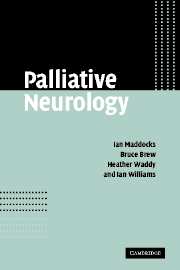Book contents
- Frontmatter
- Contents
- Foreword
- Note on drugs and abbreviations
- Section I Palliative Management
- 1 Introduction to palliation
- 2 Characteristics of palliation
- 3 Nodal points in decision-making
- 4 Common deficiencies in palliative management
- 5 Common themes in palliation practice
- Section II Major discomforts in advanced neurological illness
- Section III Major neurological conditions requiring palliation
- Section IV Ethical issues
- Section V Appendices
- Index
2 - Characteristics of palliation
from Section I - Palliative Management
Published online by Cambridge University Press: 08 January 2010
- Frontmatter
- Contents
- Foreword
- Note on drugs and abbreviations
- Section I Palliative Management
- 1 Introduction to palliation
- 2 Characteristics of palliation
- 3 Nodal points in decision-making
- 4 Common deficiencies in palliative management
- 5 Common themes in palliation practice
- Section II Major discomforts in advanced neurological illness
- Section III Major neurological conditions requiring palliation
- Section IV Ethical issues
- Section V Appendices
- Index
Summary
The following underlying characteristics have been claimed for palliative care. How well do they apply in palliation for an incurable neurological condition?
IT IS PATIENT-CENTRED
Relief of discomfort is the central focus of palliation. An understanding of the underlying pathology remains important for determining the basis of discomforts, and for recognizing where measures aimed at that pathology can improve quality of life, but treatment directed at the underlying disease often is of less importance. Now the assessment and management of the many effects of the disease that diminish the well-being and the dignity of the patient assume prime importance. They include physical discomforts such as weakness and incoordination; emotional frustration from imposed dependency; anxiety about being a burden to others, and spiritual distress with feelings of guilt or unresolved anger, a sense of life losing its meaning, being left without hope for the future. Key elements in human well-being and dignity are the maintenance of a sense of control, and the opportunity to exercise choice. Both are commonly eroded in advanced neurological disease. The term ‘existential pain’ is sometimes used as a metaphor to indicate suffering that seems to have little connection to physical distress or pain. It is a vague term, thought variously to indicate guilt, isolation through illness, or disappointment and impending separation.
As function deteriorates, friends run out of conversation and commitment dwindles. Although cultural contexts vary, it is not uncommon for persons with chronic neurological diseases to become emotionally and physically isolated as their condition progresses.
- Type
- Chapter
- Information
- Palliative Neurology , pp. 12 - 19Publisher: Cambridge University PressPrint publication year: 2005



